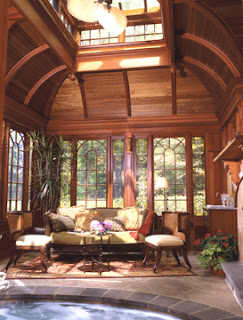How Does Your Sunroom
Grow?
by
Stephanie Cavanaugh
For
the Wall St Journal's OWN Magazine - September 2012
Molly
and Michael Metzler sleep under glass. Their bedroom opens to a domed
conservatory with marble floors and a panoramic view that skips across 15 acres
of garden and grounds to the lapping shore of Delaware's Nanticoke River.
From
the boudoir one also sees a free-standing conservatory nestled in a woodsy
setting and echoing the style of the 5,000 square foot main house. Molly
Metzler originally wanted a simple greenhouse, but the project grew, as these
things do, into a mahogany-lined, cupola-topped jewel-box, with windows set in
bronze.
"It's
much too nice to be a greenhouse," she says of the single-room building
that features a sitting area with a fireplace, a wet bar, and an in-ground spa
for splashing amid hibiscus flowers and banana trees in the middle of January.
"It's
just a place for my husband and me. We don't even let my son out there," then
adds with a laugh, "He's 21. You don't want one of those in your
spa."
It's June
in January
Fooling
mother nature is a great part of the allure of green houses, conservatories,
and orangeries. Though the terms are often used interchangeably, there are
differences between these structures.
Greenhouses,
which are generally detached from the house, are designed for the propagation
of plants, with heating and lighting controls to create the optimum environment
for your eupatoria and fritillaria.
Conservatories are usually attached to the house and allow
the harmonious cohabitation of plants and brunch.
The orangerie is a cousin to both. Originally designed
to grow citrus trees in climates too chilly to sustain them outdoors, they are
generally defined by a two-tiered roof that allows headroom for trees.
There
is, however, considerable overlap among the three forms. A conservatory might
have a domed roof and an orangerie a flat one, with no glassing at all. A
greenhouse can be used for reading as well as raising flowers and plants.
"We've
done greenhouses that incorporated relaxation rooms with tables and
chairs," says Rob Suman, president of Creative Conservatories, which is
based in Quakertown, Pennsylvania. "They're all glass structures, of
course, and very similar."
To be
frank (which is nice), he adds that whatever we call them, what we're talking
about is building magnificently ornamented sunrooms. Rooms that will
become, as he puts it, "the jewel of the house."
Having
been given Suman's absolution, and to simplify matters, we'll dispense with the
distinctions and simply call all of these glass rooms conservatories, since
that is their ultimate function: to conserve plants.
A LITTLE HISTORY BREAK
"Twenty
years ago, when we started this company, most people were doing greenhousy
kinds of things, says Alan Stein, the owner of Tanglewood Conservatories,
who along with his partner Nancy Virts designed and built the Metzler's bedroom
addition and woodsy retreat. "Conservatories were few and far between;
people had not really moved toward classically detailed designs."
"The
conservatory harkens back to a long history, starting in Europe," says
Stein. Beginning in the 16th century, conservatories were used to cultivate
fruit trees on private reserves with inclement climates. By the 19th century
they'd entered their heyday as public buildings, like London's Kew Gardens,
exhibiting exotic flowers and foliage to delighted visitors.
While
George Washington and others had a private conservatories, public gardens did
not become common in this country until the 20th century when we began building
elaborate glass structures to rival those of the Europeans. Visitors flocked to
them, taking pleasure in sniffing mid-winter blossoms in such elaborately
elegant edifices as New York's Haupt Conservatory and the U.S. Botanic Garden
at the foot of the U. S. Capitol.
They
were admired as much for their architecture and charm as for their plant life.
"Little
by little, people thought: Let's eat out here." says Stein.
REDEFINING THE CONSERVATORY
Increasingly
popular are kitchen additions and extensions, family rooms, and "bedrooms
-- so owners wake when the sun comes up." says Rob Suman, who added with a
laugh: "They have no choice."
This
is largely a market for the affluent, he cautions. Most buyers are in their
forties or older and they think about it long before building. "I
have a client that's been collecting photos for ten years. I drew five
different versions before we came up with what made sense. There's not a quick
press of the button to design it right."
At
Tanglewood, while most of the conservatories built by Stein's internationally
known company are traditionally styled, "they don't have to be," he
says.
"I
live in a modern house and love modern architecture, though we don't design to
any particular one style," he says. "Perhaps because of their origin
during the nineteenth century, conservatories tend to lean toward the
classical, but people are not looking for a strict interpretation. They
appreciate a well-proportioned, nicely-detailed design.”
Suman
says his clients enjoy the feeling "that you're outside when you're
inside. To stand out in the rain in a lightning storm and not get wet? To be in
a snowstorm and its 80 degrees inside?"
Or
to swim in a tropical bubble as the winter winds howl outside the windows.
Paradisiacal
as they sound, pool enclosures are among the more complicated installations,
with a climate that needs to suit not only people and plants, and an exposed
and fairly large body of water.
Now
in its second year of construction is a 6,000 square foot conservatory with
twenty foot walls that Suman's company is building into the side of a mountain
in Pennsylvania.
Sitting
on a granite foundation, itself a marvel of engineering, is an irregularly
shaped pool backed by an 18 foot rock wall "with little pools and a
waterfall that you can sit behind." Fifteen feet above the main pool is a
lounging area with a refrigerator and a bar. Below that, against a rock wall,
is a bath with a shower. "You can live in this space," he says.
Up On the
Roof -- Or the Terrace
Adding
a conservatory to a terrace or rooftop might be easier, or at least less
insane, than you might think. And, ah! The payoff!
Stein's
firm has designed buildings of glass for estates, city apartments, and rooftops
round the world.
Recently
completed is a roof aerie for a building on New York's Park Avenue that the
owners use as a living space, "It's both a plant and a people room,"
he says.
"You
can't build one of these and not fill it with plants," Stein says.
"The light is so wonderful and everything does so well." So the owners set a wrought iron
bistro table amid the palms and fichus and watch the seasons change from the
wicker settee.
Conservatories
built for city homes "are smallish," he says, adding, "You don't
have a lawn." Most are kept to less than 300 square feet and "there
are usually French doors opening to a small patio where you can open the doors
in summer and put out your plants."
The
Park Avenue project was created in sections small enough to be bundled into an
elevator and fit through a standard doorway.
Because
of their weight, roof installations frequently require more engineering than
those at ground level, but the assembly is straightforward. Like Stein, Rob
Suman's crew "...precuts and ships to the site. It's pieces and parts. It
installs quickly -- the fine woodworking is not done in the field, it's done in
the shop.
"Once you've parked your vehicle, you're
golden."
Rizzoli,
which consistently publishes some of the most magnificent books in existence,
has two beautifully designed and comprehensive guides to creating and living in
conservatories.
Rooftop Gardens: The Terraces, Conservatories and
Balconies of New York by Denise LeFrak Calicchio and Roberta Model Amon
includes, among other choice specimens, a 2,000 square foot terrace
garden and a conservatory. This glassed space functions as both a living
room and an indoor garden for the winter cultivation of a collection of fruit
trees, amaryllis, camellias, and the heavenly scented paperwhite narcissus.
Conservatory Style: Garden Rooms, Glasshouses, and
Sunrooms by
Jackum Brown is an indispensable dream guide to these glassed wonders.
183 pages of conservatories large and small, elaborate and simple, in sun and
snow, as kitchens and baths, family rooms and pool enclosures. Brown
includes a comprehensive guide to plants and planting and furnishings, as
well.
For
the aspiring green thumb, Fulcrum Publishing offers Greenhouse Gardener's Companion: Growing Food & Flowers in your
Greenhouse or Sunspace by Shane Smith, which offers guidelines for
selecting suitable plants, propagation techniques, interior design and
climate control, and -- for that fly in your ointment -- how to deal with
pests.
Stephanie Cavanaugh
blogs about gardening and design at www.whoneedsflowers.blogspot.com








nice pictures and content liked it
ReplyDeletesplendid lake dew